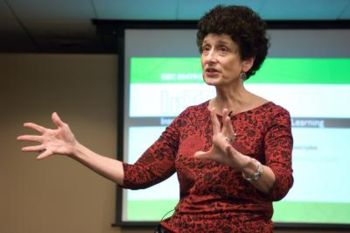Taylor draft one
From DigitalRhetoricCollaborative
Prior to coming to Georgia Tech in 1999, Murray was a Senior Research Scientist in the Center for Educational Computing Initiatives at MIT. There, starting in 1971, she taught humanities and led advanced interactive design projects. Murray is widely known as an early developer of humanities computing applications, a theorist of digital media (hyperlink), and an advocate for new educational programs in digital media. Her most notable works are Hamlet on the Holodeck: The Future of Narrative in Cyberspace, The New Media Reader, and Inventing the Medium.
Contents |
Career and Contributions
In the early eighties while Murray was teaching in the humanities department at MIT, her students showed her ELIZA and Zork. They caused Murray to see storytelling potential in new digital mediums. Murray's first major book is [ Hamlet on the Holodeck: The Future of Narrative in Cyberspace . Hamlet on the Holodeck explores asks the question of whether the computer can successfully provide a basis for the narrative form, just like print technology supported the development of the novel and film technologies supported the success of film. Murray believes so. She bases her analysis on the idea that the computer can be used as a medium of representation with a set of distinct properties. Murray attests that the computer is procedural, participatory, encyclopedic, and spatial. Those things afford three characteristic pleasures: immersion, agency, and transformation. Murray’s main point is that the new formats available in computers broaden the possibilities of creativity in storytelling. Murray’s work has been referenced by interactive television producers, game designers, journalists, and filmmakers.
In Inventing the Medium, Murray explains that:Innovative interaction designers should think of all objects made with bits--whether games or Web pages, robots or the latest killer apps--as belonging to a single new medium: the digital medium. Designers can speed the process of useful and lasting innovation by focusing on the collective cultural task of inventing this new medium. Exploring strategies for maximizing the expressive power of digital artifacts, Murray identifies and examines four representational affordances of digital environments that provide the core palette for designers across applications: computational procedures, user participation, navigable space, and encyclopedic capacity.[2]
praised by Harry Jacobs, with him saying it was "epic accomplishment, one which we will all be mining for years to come."[3]
Murray had an active role in developing two new degree programs for Georgia Tech, which were launched in 2004. They were the Ph.D. in Digital Media, and the B.S. in Computational Media.
Awards and Accomplishments
- Emerita trustee of the American Film Institute (active 2000-2009).[4]
- Emerita trustee of the board of directors for the George Foster Peabody Award (active 2006-20013).[5]
- Founded the eTV Lab at Georgia Tech.[6]
- In 2010, Prospect Magazine named her one of the "Top Ten Brains for the Digital Future".[7]
Related Topics
- Affordances
- Digital Poetry
- Artificial Intelligence
- New Media Art
- Digital Theory
References
- ↑ http://lmc.gatech.edu/~murray/
- ↑ http://mitpress.mit.edu/books/inventing-medium
- ↑ http://lmc.gatech.edu/~murray/
- ↑ http://lmc.gatech.edu/~murray/
- ↑ http://lmc.gatech.edu/~murray/
- ↑ http://etv.gatech.edu
- ↑ http://lmc.gatech.edu/~murray/

